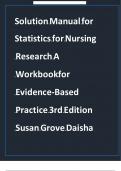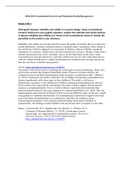Solution Manual for
b b
Statistics for Nursing
b b
b Research A b
b Workbookfor b
b Evidence-Based
b Practice 3rd Edition
b b
b Susan Grove Daisha
b b
, Answer bGuidelines bfor bQuestions bto bBe
bGraded
EXERCISE
Identifying Levels b
1
b
b ofMeasurement: Nominal,
b b
Ordinal, Interval, and
b b b
Ratio b
The bquestions bare bin bbold bfollowed bby banswers.
1. In bTable b1, bidentify bthe blevel bof bmeasurement bfor bthe bcurrent btherapy bvariable.
bProvide ba brationale bfor byour banswer.
Answer: bThe bcurrent btherapy bvariable bwas bmeasured bat bthe bnominal blevel. bThese bdrug
bcategories bwere bprobably bdeveloped bto bbe bexhaustive bfor bthis bstudy band bincluded bthe
bcategories bof bdrugs bthe bsubjects bwere breceiving. bHowever, bthe bcategories bare bnot
bexclusive, bsince bpatients bare busually bon bmore bthan bone bcategory bof bthese bdrugs bto
bmanage btheir bhealth bproblems. bThe bcurrent btherapies bare bnot bmeasured bat bthe bordinal
blevel bbecause bthey bcannot bbe brank bordered, bsince bno bdrug bcategory bcan bbe bconsidered
bmore bor bless bbeneficial bthan banother bdrug bcategory b(see bFigure b1-1; bGrove b& bGray,
b2019).
2. What b is b the b mode b for b the b current b therapy b variable b in b this b study? b Provide b a
b rationale b forbyour banswer.
Answer: b The b mode b for b current b therapy b was b β bblocker. b A b total b of b 100 b (94%) b of b the b cardiac
b patients
were b receiving b this b category b of b drug, b which b was b the b most b common b prescribed
b drug b for b thisbsample.
3. What bstatistics bwere bconducted bto bdescribe bthe bBMI bof bthe bcardiac bpatients bin
bthis bsample? bDiscuss bwhether bthese banalysis btechniques bwere bappropriate bor
binappropriate.
Answer: b BMI b was b described b with b a b mean b and b standard b deviation b (SD). b BMI
b measurement b resulted bin bratio-level bdata bwith bcontinuous bvalues band ban babsolute bzero
b(Stone b& bFrazier, b2017). bRatio- blevel bdata bshould bbe banalyzed bwith bparametric bstatistics
bsuch bas bthe bmean band bSD b(Grove b& bGray,b2017; bKnapp, b2017).
4. Researchers bused bthe bfollowing bitem bto bmeasure bregistered bnurses’ b(RNs) bincome bin
ba bstudy:bWhat bcategory bidentifies byour bcurrent bincome bas ban bRN?
a. b Less bthan b$50,000
b. b $50,000 bto b59,999
c. b $60,000 bto b69,999
d. b $70,000 bto b80,000
e. b $80,000 bor bgreater
What b level b of b measurement b is b this b income b variable? b Does b the b income b variable
b follow b the brules boutlined bin bFigure b1-1? bProvide ba brationale bfor byour banswer.
Answer: b In bthis b example, bthe bincome b variable bis bmeasured b at b the b ordinal blevel. bThe
b income b catego- bries bare bexhaustive, branging bfrom bless bthan b$50,000 bto bgreater bthan
b$80,000. bThe btwo bopen-ended
,AG b1-1
, AG b1-2 Answer b Guidelines b for b Questions b to b Be b Graded
categories bensure bthat ball bsalary blevels bare bcovered. bThe bcategories bare bnot bexclusive, bsince
bcatego- bries b(d) band b(e) binclude ban b$80,000 bsalary, bso bstudy bparticipants bmaking
b$80,000 bmight bmark beither b (d) b or b (e) b or b both b categories, b resulting b in b erroneous
b data. b Category b (e) b could b be b changed bto bgreater bthan b$80,000, bmaking bthe bcategories
bexclusive. bThe bcategories bcan bbe brank bordered bfrom bthe blowest bsalary bto bthe bhighest
bsalary, bwhich bis bconsistent bwith bordinal bdata b(Grove b& bGray, b2019; bWaltz bet bal.,
b2017).
5. What blevel bof bmeasurement bis bthe bCDS bscore? bProvide ba brationale bfor byour banswer.
Answer: bThe bCDS bscore bis bat bthe binterval blevel bof bmeasurement. bThe bCDS bis ba b26-
item bLikert bscale bdeveloped bto bmeasure bdepression bin bcardiac bpatients. bStudy
bparticipants brated btheir bsymp- btoms bon ba bscale bof b1 bto b7, bwith bhigher bnumbers
bindicating bincreased bseverity bin bthe bdepression bsymptoms. bThe btotal bscores bfor beach
bsubject bobtained bfrom bthis bmulti-item bscale bare bconsidered bto bbe bat bthe binterval blevel
bof bmeasurement b(Gray bet bal., b2017; bWaltz bet bal., b2017).
6. Were bnonparametric bor bparametric banalysis btechniques bused bto banalyze bthe bCDS
bscores bforbthe bcardiac bpatients bin bthis bstudy? bProvide ba brationale bfor byour banswer.
Answer: bParametric bstatistics, bsuch bas b mean b and b SD, b were b conducted b to b describe
b CDS b scores bfor bstudy bparticipants b(see bTable b1). bCDS bscores bare binterval-level bdata bas
bindicated bin bQuestions b5, bso bparametric bstatistics bare bappropriate bfor bthis blevel bof bdata
b(Gray bet bal., b2017; bKim b& bMallory, b2017).
7. Is bthe bprevalence bof bdepression blinked bto bthe bNYHA bclass? bDiscuss bthe bclinical
bimportance bof bthis bresult.
Answer: bThe bstudy bnarrative bindicated bthat bthe bprevalence bof bdepression bincreased bwith
bthe bgreater bNYHA bclass. bIn bNYHA bclass bIII, b64% bof bthe bsubjects bwere bdepressed,
bwhereas b11% bof bthe bsubjects bwere bdepressed bin bNYHA bclass bI. bThus, bas bthe bNYHA bclass
bincreased, bthe bnumber bof bsub- bjects bwith bdepression bincreased. bThis bis ban bexpected bfinding
bbecause bas bthe bNYHA bclass bincreases, bcardiac bpatients bhave bmore bsevere bphysical
bsymptoms, bwhich busually bresult bin bemotional bdistress, bsuch b as b depression. b Nurses b need
b to b actively b assess b cardiac b patients b for b depression, b especially b those bin bhigher bNYHA
bclasses, bso bthey bmight bbe bdiagnosed band btreated bas bneeded.
8. What bfrequency band bpercent bof bcardiac bpatients bin bthis bstudy bwere bnot bbeing
btreated bwith ban bantidepressant? bShow byour bcalculations band bround byour banswer
bto bthe bnearest bwhole bpercent b(%).
Answer: bA btotal b bof b b106 b bcardiac b bpatients b bparticipated b bin b bthis b bstudy. b bThe b
bsample b bincluded b15 bpatients bwho bwere breceiving ban bantidepressant b(see bTable b1).
bThe b bnumber b bof b bcardiac bpatients b not b treated b for b depression b was b 91 b (106 b – b 15
b = b 91). b The b group b percent b is b calculated bby b the b following b formula: b (group
b frequency b ÷ b total b sample b size) b × b 100%. b For b this b study, b(91 bpatients b÷ b106
bsample bsize) b× b100% b= b0.858 b× b100% b= b85.8% b= b86%. bThe b bfinal banswer b is
b rounded b to b the b nearest b whole b percent b as b directed b in b the b question. b You b could
b have balso bsubtracted bthe b14% bof bpatients btreated bwith bantidepressants bfrom b100% band
bobtained bthe b86% b who b were b not b treated b with b an b antidepressant.
9. What bwas bthe bpurpose bof bthe b6-minute bwalk btest b(6MWT)? bWould bthe b6MWT
bbe buseful bin bclinical bpractice?
Answer: bHa bet bal. b(2018) bstated, b―The b6-min bwalk btest b(6MWT) bis ba bmeasure bof bthe
bsubmaximal, bsteady-state bfunctional bcapacity‖ bof bcardiac bpatients. bThis btest bwould bbe ba
bquick, beasy bway bto bdetermine ba bcardiac bpatient’s bfunctional bstatus bin ba bclinical b
bsetting. b bThis b bfunctional b bstatus bscore b could b be b used b to b determine b the b treatment
b plan b to b promote b or b maintain b functional b statusbof bcardiac bpatients.





